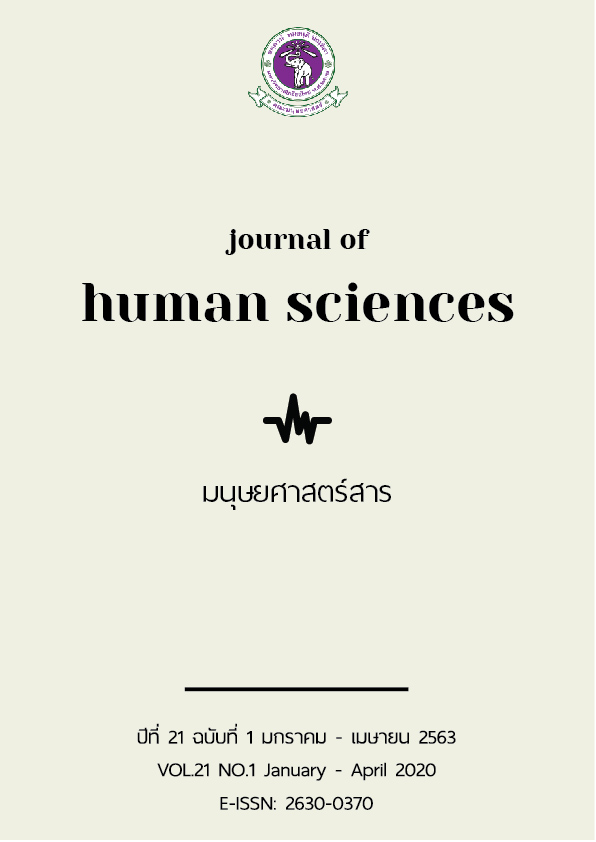การวิเคราะห์อนุภาคในนิทานพื้นบ้านรัฐ “เกรละ”ประเทศอินเดีย ภาพสะท้อนความเชื่อและวิถีชีวิต
Main Article Content
บทคัดย่อ
นิทานพื้นบ้านเป็นผลผลิตทางวัฒนธรรมที่เกิดจากจินตนาการ อันสามารถสะท้อนให้เห็นระบบความคิด ความเชื่อ วีถีชีวิตและวัฒนธรรมของกลุ่มชนได้ บทความนี้เป็นส่วนหนึ่งของวิจัยเรื่อง “การพัฒนากิจกรรมการเรียนรู้เชิงสร้างสรรค์โดยประยุกต์ใช้อนุภาคเพื่อส่งเสริมมโนทัศน์เรื่องอนุภาคในนิทานพื้นบ้าน ความสามารถด้านการเขียนเชิงสร้างสรรค์และพัฒนาความสามารถของผู้เรียนในศตวรรษที่ 21” โดยบทความนี้มีจุดประสงค์เพื่อ 1) วิเคราะห์นิทานพื้นบ้าน “เกรละ”ประเทศอินเดียด้วยอนุภาค และ 2) วิเคราะห์ภาพสะท้อนความเชื่อและวิถีชีวิตจากนิทานพื้นบ้าน ขอบเขตของข้อมูลใช้นิทานที่เก็บรวบรวมในระยะเวลา 1 เดือน คือพฤษภาคม 2562 วิธีการศึกษาใช้การวิเคราะห์เอกสาร ผลการศึกษาพบว่า 1) อนุภาคที่พบแบ่งได้เป็น 3 กลุ่ม คือ อนุภาคกลุ่มเทพเจ้า สิ่งเหนือธรรมชาติและความมหัศจรรย์ต่างๆ อนุภาคกลุ่มสถานะ นิสัยและพฤติกรรมของมนุษย์ และสัตว์ และอนุภาคเกี่ยวกับความจริงของชีวิต และ 2) ภาพสะท้อนความเชื่อและวิถีชีวิตจากนิทานพื้นบ้าน พบดังนี้ ด้านความเชื่อ ได้แก่ ความเชื่อเรื่องเทพเจ้าในศาสนาฮินดู ความเชื่อเกี่ยวกับอำนาจเหนือธรรมชาติของโอดิยัน ความเชื่อว่าโอ่งจีนคือสัญลักษณ์ของความโชคดี ด้านสภาพสังคมและวิถีชีวิต ได้แก่ ดินแดนแห่งมะพร้าว ความผูกพันของคนกับช้าง สังคมการเกษตรที่ผูกพันกับธรรมชาติ และการคมนาคมโดยเรือ
ผลการวิเคราะห์แสดงให้เห็นว่านิทานเต็มไปด้วยอนุภาคที่สะท้อนให้เห็นระบบความคิด ความเชื่อ วิถีชีวิตของคนในสังคมต่างๆ ได้ ฉะนั้นอนุภาคจากนิทานพื้นบ้านจะเป็นสื่อที่ช่วยให้คนต่างสังคมได้เข้าใจวัฒนธรรมที่แตกต่างกันมากขึ้น
Article Details
เอกสารอ้างอิง
Beena, T.D. (2017). Mythological Representations in the Traditions of Kerala. National Journal of Hindi & Sanskrit Research. 1(13), 58-60.
BhagirathArtofstory. (2018). Odiyan the Myth. Retrieved from
https://artofstorylitfictionalterreality.wordpress.com/2018/04/20/odiyan-the-myth/.
Homfung, Ch.(2019). The Development of Creative Learning Activities to teach motif in folktale and Develop Students' Abilities in the 21st Century. Proceeding of Joint International Education Conference: The 8th PSU Education Conference & 4th Inspirational Scholar Symposium (ISS) 2019 “Growth Mindset Innovative and Integrated Work-Ready Education”, Thailand. 12-13 December 2019. pp.174-181.
Jonnelle Desierto Fagsao.(2019). “Into The Woods: A Motif Mainstreaming of “Imontanosa’s” Eschatological Legends.” International Journal of Humanities and Social Sciences. 8 (2) ,37-47.
Mohanadasan, S. (2019).The story about Kerala. Interviewing (7 July 2019).
Na. Thalang, S. (2009). Thritsadi khati chon witthaya withi witthaya nai kan wikhro̜ tamnan - nithan phưnban [The folklore theory: methodology to analyze legend and the folktale]. Bangkok: Chulalongkorn university.
Patjusanon, S. (2017). Kansang san anuphak khwam wiset nai nawaniyai mahatsachan rưang dœwairot [The Creation of Magic Motif in Fantasy Novel the White Road]. Warasan wichakan manutsayasat læ sangkhommasat, 25(47), 149-190.
Royal Thai Consulate-General, Chennai, India (2015).Kho̜mun phưnthan kho̜ng rat ken la [The background of Kerala]. Retrieved from
http://www.thaiembassy.org/chennai/th/relation/5208/
Sreevalsam, R.(2008). Old Chinese Jars. Retrieved from
https://www.flickr.com/photos/k_a_a_z_h_c_h_a/2958118319
Sueangam, S. (2019.) Ratken la to̜n nưng okat ngam thamklang rat to̜n tai kho̜ng India [Kerala episode 1 The great opportunities in the southern Indian state]. Retrieved from https://thaiindia.net/site_content/53-know-indian-states/1764-1-1764.html
Thai Trade Center, Mumbai, India. (2014). Next Station “Kerala”. @Mumbai, 3(1), 1-5.
Thetsuk, S. and Boonsong, B. (2016). Kansưksa anuphak nithan mia no̜ma chak phonnga nakan riapriang kho̜ng nu - yingo̜ nưng [The study of Motifs in Myanmar Folktales Compiled by Nu-Yin]. The Humanities Journal of Naresuan University. 13(3), 107-122.
Thompson, Stith. (1977). The Folktale. Berkeley: University of California Press.
_________(1966). Motif-index of folk-literature: a classification of narrative elements in folktales. Bloomington, Ind, : Indiana University Press.
Thompson, Stith. And Balys, Jonas. (1958). The Oral Tales of India. Bloomington, Ind, : Indiana University Press.
Vishnu temple. Retrieved from http://spst.in/temple-history/
เอกสารอ้างอิงรูปภาพ
Avittathur Siva Temple (Mahadeva Temple). Retrieved from
https://www.astrolika.com/temples/avittathur-siva-temple.html
Chinese Jar in Padmanabhapuram palace. Retrieved from https://www.padmanabhapurampalace.org/photo-gallery.
Kerala map. Retrieved from http://www.maps-india.com/kerala/kerala-festival-map.html
Odiyan Advertisement poster in 2018. Retrieved from https://uae.voxcinemas.com/movies/odiyan-malayalam..
Padmanabhaswamy temple. Retrieved from
https://www.deccanherald.com/content/404251/excavation-stopped-padmanabhaswamy-temple.html.
The symbol of Kerala state. Retrieved from https://kerala.gov.in/


